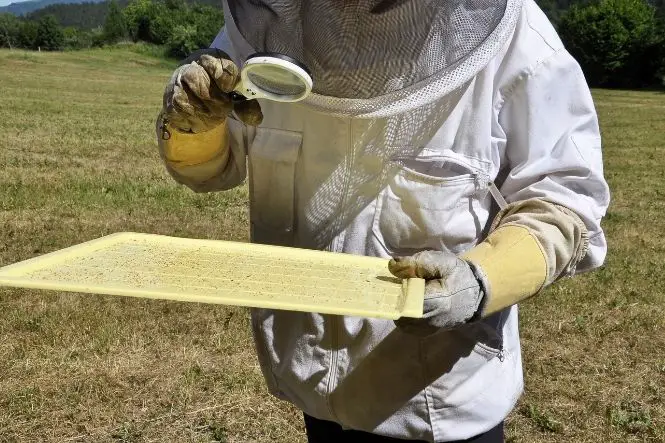Mites are small invertebrates from the group Arachnida, the same group as spiders. Many people are not aware of the mites around them, as most mites are microscopic.
Mites as Pests
Mites live all around the world, and many are pests, such as red spider mites, which attack plants, and sarcoptic mange mites, which cause skin disease in animals. House dust mites live off flakes of human skin and may trigger asthma and other allergies. Varroa mites (Varroa destructor) are parasites of honeybees and are causing destruction of honeybee colonies around the world.
Cheese mites live in cheese, grains, flour, cured meats and insect detritus. They are pearly white and 0.4-0.7 mm long. Cheese mites include Tyrolichus casei and Tyrophagus casei. Most cheese makers think of cheese mites as pests, because they change the flavour of cheese and leave behind a fine grey dust. They can also cause mild dermatitis (itching) and asthma. However, some cheese makers, who make kinds of cheese like Milbenkäse and Mimolette, introduce cheese mites on purpose to give the cheese a particular flavour.
The film thought to be the first ever science documentary was a one-minute silent movie of cheese mites, shown in a cinema in 1903.
Mites as Neighbours
Demodex mites live in and around the roots of hairs on humans and other mammals. Humans have mites living on their eyelashes, called eyelash mites, including Demodex folliculorum and Demodex brevis. These are very tiny, only about 0.3 to 0.4 mm long, and eat skin flakes and natural oil from the skin, called sebum.
Eyelash mites walk at about 8 to 16 cm/hour. Older people are more likely to have eyelash mites – they are seen in about 96 to 98% of elderly people. Eyelash mites are completely harmless unless there are an awful lot of them, when they might cause spots and itching. This is rare, and usually only happens in people who have problems with their immune systems.
Looking at Mites
To look at mites properly needs a microscope – even a small one will make it easier to see the tiny creatures.
Carefully remove an eyelash or an eyebrow hair, put it under the microscope, and look for eyelash mites. Are there more mites on an eyelash or eyebrow hair from an older person?
Take a small piece of a blue vein from blue cheese – there may be cheese mites in it.
Bumblebees (Bombus terrestris) carry mites, including Parasitus fucorum. These are ‘commensals’, which means they live alongside the bees without causing any harm and eat rubbish that the bees leave behind. Watch out for bees pollinating flowers (carefully – female bumblebees can sting if you upset them) and see if they are carrying any mites.
Red spider mites (Tetranychus urticae) live on garden plants, including vegetable plants roses. They are about 0.5 mm long, and are greenish brown in the summer and red in the winter, so look for tiny red spots.




